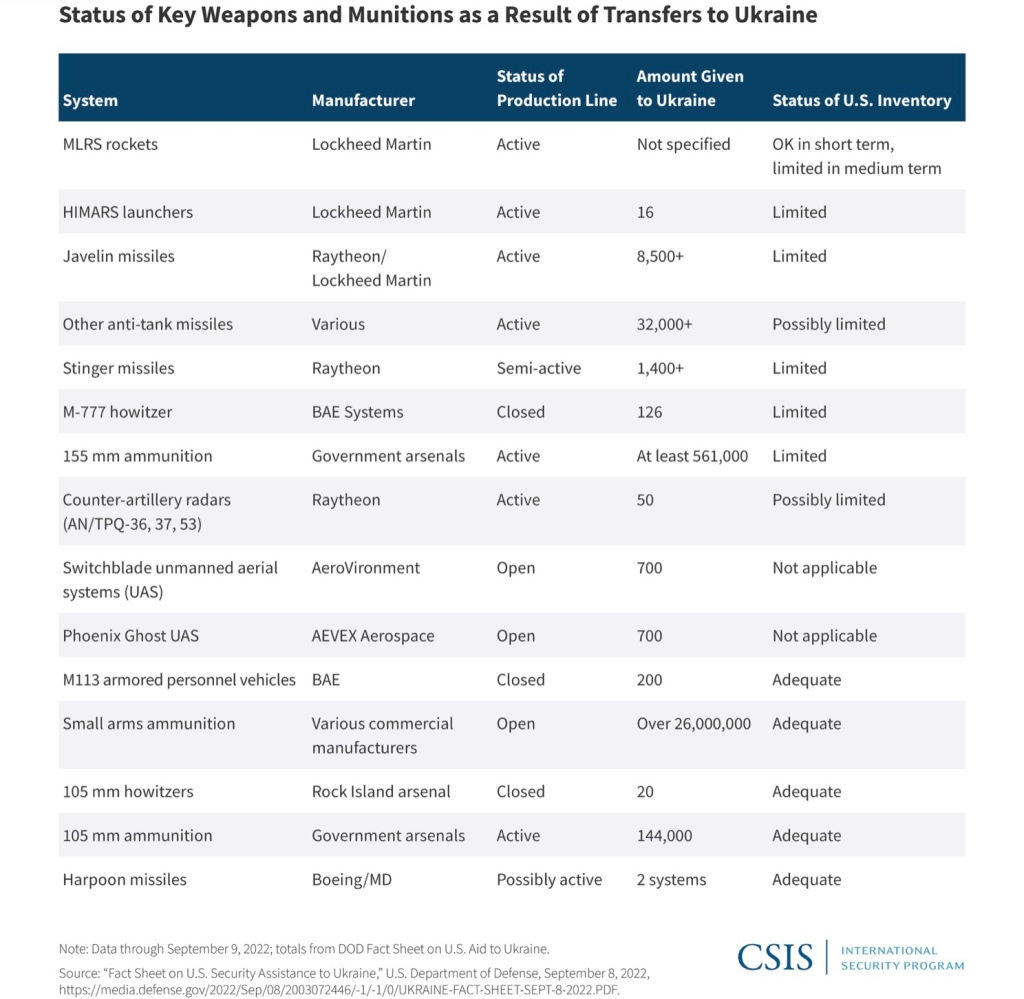To Russia, with food, tons of it (archived)

Related:
Jeffrey Sachs Discusses The War in Ukraine, ‘Shock Therapy,’ and More
To prosecute war against Russia, China, or Iran, protection of the major forward bases of the United States Air Force would be the prerequisite upon which success would be predicated.
To adequately cover even one of these large airbases against missile strikes of just 100-200 units of high-performance drones, cruise-missiles, ballistic missiles, and hypersonic missiles — plus numerous decoys — would easily require an entire Patriot battalion.
Even with a 100% interception rate, a pair of 100-missile strike packages over the course of a day would still compel a PAC-3 burn rate of at least 300 missiles, given that, as a general rule, two PAC-3 missiles are launched at every incoming target.
But of course, the interception rate would be considerably lower than 100%. And given that the Patriot command, radar, and launcher units — along with missile storage sites — would be primary targets, there would be a substantial attrition rate of the highly immobile Patriot systems themselves. (The Russians have already clearly demonstrated the vulnerability of the Patriot systems to counter-battery missile strikes. At least three Patriot batteries have been destroyed in Ukraine.)
In an attempt to cover just three large airbases against a series of salvos of 100+ missiles of various types, the entire US stockpile of PAC-3 interceptors could very conceivably be exhausted in little more than a week or two.
Current annual production could easily be consumed in little more than a day or two.
This is the reality of 21st century high-intensity conflict against an adversary with the capability to shoot back — a kind of war for which the United States military is woefully ill-prepared, both materially and doctrinally.
The Biden administration has been criticized in recent days over the support offered to survivors of the deadly wildfires in Maui, compared to the billions in U.S. aid sent to Ukraine.
Joe Biden’s Aid to Hawaii vs Ukraine Aid Compared: What We Know
To date, the Biden-Harris Administration has approved nearly $7 million in assistance to nearly 2,200 households, including nearly $3 million in initial rental assistance.
White House Calls for $40 Billion Supplemental
If enacted, the supplemental would provide $24.0 billion of additional aid to Ukraine – on top of the $113 billion the United States provided in 2022 alone. This includes $13.1 billion of military aid and replenishment of Pentagon weapons stocks, $8.7 billion of economic and humanitarian aid, and $2.3 billion to leverage additional aid from other donors through the World Bank.
That’s approximately $137 billion to Ukraine, $10 million, or so, for Hawaii (in soft loans and rental assistance)!
American arms stockpiles in Israel have begun to shrink, Israeli officials said, voicing fears Washington will exhaust munitions earmarked for use by Tel Aviv in the event of ”emergencies.” The White House has shipped weapons from its depots around the globe to fuel the Ukrainian war machine.
Israeli Officials Concerned About US Depleting Ammunition Stockpiles

SUMMARY
U.S. munitions stockpiles are rapidly being depleted as the Ukraine war continues. Sufficient stockpiles of munitions are vital to the U.S. defense. Once the stockpiles are expended, the Department of Defense cannot simply buy more munitions—manufacturing takes years. Congress and the Department of Defense must ensure that the U.S. has sufficient stockpiles to meet the challenges of the modern era while working with manufacturers to make the industry as responsive as possible.
Rapidly Depleting Munitions Stockpiles Point to Necessary Changes in Policy
Either this narrative about weapon stockpiles, being depleted, is part of the information war or Russia is demilitarizing NATO!?!
U.S. and NATO scramble to arm Ukraine and refill their own arsenals
In Ukraine, the kind of European war thought inconceivable is chewing up the modest stockpiles of artillery, ammunition and air defenses of what some in NATO call Europe’s “bonsai armies,” after the tiny Japanese trees. Even the mighty United States has only limited stocks of the weapons the Ukrainians want and need, and Washington is unwilling to divert key weapons from delicate regions like Taiwan and Korea, where China and North Korea are constantly testing the limits.
…
So the West is scrambling to find increasingly scarce Soviet-era equipment and ammunition that Ukraine can use now, including S-300 air defense missiles, T-72 tanks and especially Soviet-caliber artillery shells
…
There are even discussions about NATO investing in old factories in the Czech Republic, Slovakia and Bulgaria to restart the manufacturing of Soviet-caliber 152-mm and 122-mm shells for Ukraine’s still largely Soviet-era artillery armory.
…
The European Union has approved €3.1 billion ($3.2 billion) to repay member states for what they provide to Ukraine, but that fund, the [ironically-named] European Peace Facility, is nearly 90 percent depleted.
…
Smaller countries have exhausted their potential, another NATO official said, with 20 of its 30 members “pretty tapped out.” But the remaining 10 can still provide more, he suggested, especially larger allies. That would include France, Germany, Italy and the Netherlands.
NATO’s secretary general, Jens Stoltenberg, has advised the alliance — including, pointedly, Germany — that NATO guidelines requiring members to keep stockpiles should not be a pretext to limit arms exports to Ukraine. But it is also true that Germany and France, like the United States, want to calibrate the weapons Ukraine gets, to prevent escalation and direct attacks on Russia.
…
Washington is also looking at older, cheaper alternatives like giving Ukraine anti-tank TOW missiles, which are in plentiful supply, instead of Javelins, and Hawk surface-to-air missiles instead of newer versions. But officials are increasingly pushing Ukraine to be more efficient and not, for example, fire a missile that costs $150,000 at a drone that costs $20,000.
The United States alone has given more than 1 million artillery shells, according to a report from the Department of Defense. But the U.S. is not alone. Although not to that scale, European nations have been steadily aiding Ukraine’s defense efforts. Now other allied nations are starting to worry they won’t have enough armaments for their own self-defense. The Associated Press reported that European nations are worried about their arms supplies should Russian aggression reach them.
The war in Ukraine is draining Western munition stockpiles
New $1.1 Billion Arms Package for Ukraine Includes 18 HIMARS Launchers
The HIMARS that the US has been sending to Ukraine are equipped with missiles that have a range of about 50 miles. But that can change, and Kyiv is requesting Army Tactical Missile Systems, which have a range of 190 miles, but Washington has been hesitant to send the longer-range missiles. Russia has warned that providing such arms would cross a “red line.”
Related:
The U.S. and Europe are running out of weapons to send to Ukraine
In the U.S. weapons industry, the normal production level for artillery rounds for the 155 millimeter howitzer — a long-range heavy artillery weapon currently used on the battlefields of Ukraine — is about 30,000 rounds per year in peacetime.
The Ukrainian soldiers fighting invading Russian forces go through that amount in roughly two weeks.
…
Is the U.S. ability to defend itself at risk?
The short answer: no.
…
The U.S. has essentially run out of the 155 mm howitzers [M777?] to give to Ukraine; to send any more, it would have to dip into its own stocks reserved for U.S. military units that use them for training and readiness. But that’s a no-go for the Pentagon, military analysts say, meaning the supplies reserved for U.S. operations are highly unlikely to be affected.

China’s neighbors are buying US weapons Washington isn’t delivering
Even though the United States views these weapons sales as integral to deterring China from attacking Taiwan, some of the deals were publicly announced as far back as 2017.
…
The reasons – government delays, supply chain issues and production requirements – are numerous, and the problem won’t be easy to fix, Rep. Mike McCaul, R-Texas, the ranking member on the House Foreign Affairs Committee, told Defense News.
…
The U.S. government has approved the sale of 10 weapons systems Taiwan has yet to receive – some of which are not slated for delivery until the end of the decade.
…
The United States has flooded billions of dollars in weapons into Ukraine, including items that are part of Taiwan’s backlog, such as Harpoon anti-ship missiles, Stinger anti-aircraft missiles and High Mobile Artillery Rocket Systems.
…
For example, several Middle Eastern and eastern European countries are ahead of Taiwan in Lockheed Martin’s F-16 production queue. In 2019, the State Department approved an $8 billion Taiwan sale for 66 F-16s, but Taipei does not expect to receive the aircraft until 2026.
“Saudi Arabia is still ahead of Taiwan on the priority list in some cases,” Rep. Mike Gallagher, R-Wis., told Defense News ahead of a July meeting with Taiwan’s Washington envoy. “We need to take a look at that.”
…
The US is expected to announce a new $3 billion weapons package for Ukraine on Wednesday as Washington is shifting to a longer-term campaign to support Kyiv in its war against Russia, US officials told The Associated Press on Tuesday.
US to Send Ukraine $3 Billion in New Military Aid as Part of Long-Term Support
You must be logged in to post a comment.